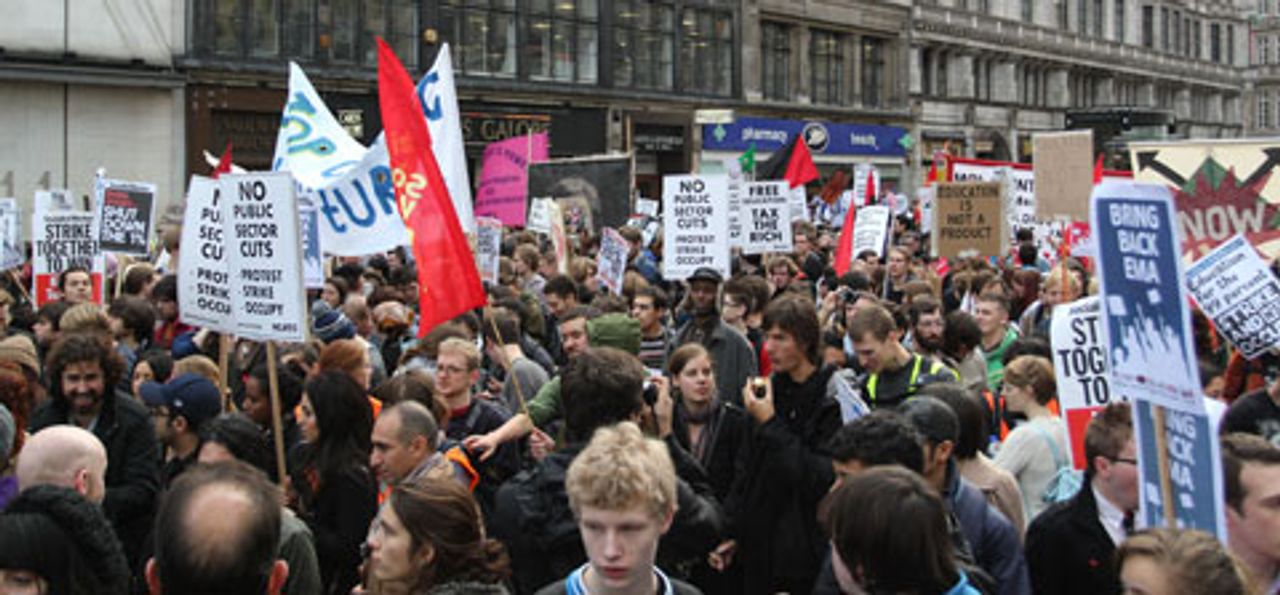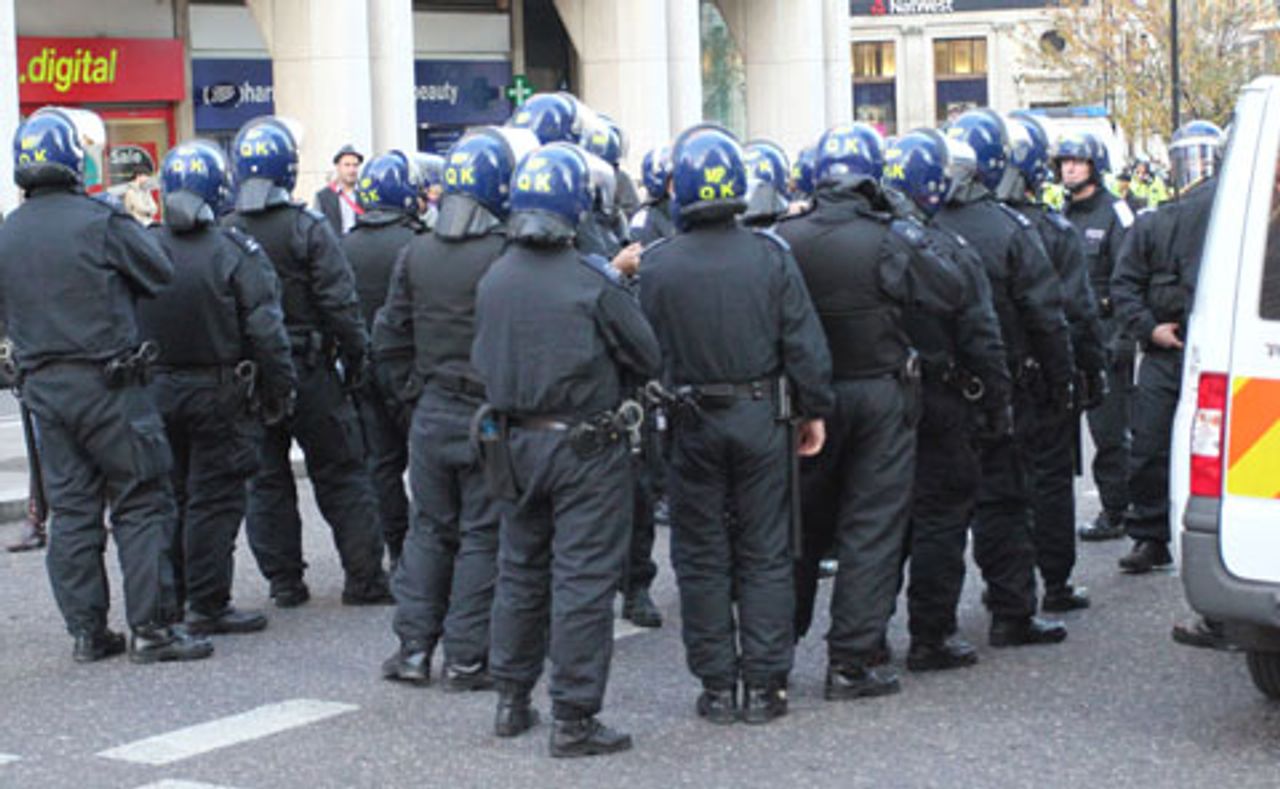 The student demonstration in London
The student demonstration in LondonThe policing of Wednesday’s students protest in London was unprecedented in its repressive character.
Around 10,000 students gathered to oppose the Conservative/Liberal-Democrat government’s attack on the right to higher education. This includes tripling of tuition fees to £9,000, abolishing the Education Maintenance Allowance of £30 per week for young people from low-income families in post-16 education and severe cuts in university and college funding. The protest Wednesday centred on the new Education White Paper, which allows private providers to offer degrees for the first time and reduces the numbers of places on courses.
In what amounts to the criminalisation of political protest, a policy described as “total policing” by the Metropolitan Police was put into operation.
 Riot police at Holborn
Riot police at HolbornOn Monday, Met authorities called a press conference, announcing that 4,000 police officers, including 500 extra officers from outside London, would be on the march—the largest mobilisation of police in the capital since the riots in August. Simon Pountain, the Metropolitan Police commander in charge, was asked if the police planned to use water cannon. He said water cannon use was not planned, but the use of rubber bullets had been authorised.
Had this ammunition been used on Wednesday, it would have been the first time ever by police at a public event on the British mainland. He revealed that the Met now had a “containment officer” to enforce so-called kettling—the forced detainment of protesters by sealing off entire areas.
On the day of the protest, the capital was on lock-down and entire areas were blocked off. Police vans, mounted police and 10 feet high barricades were set up at numerous locations. Those arriving from railway and local underground stations were approached by police officers and given an 11-page brochure, with the emblem of the Metropolitan Police and the words “TOTAL POLICING” on the front and back.
The brochure said the police intended to use section 60 of the Criminal Justice and Public Order Act 1994, which “gives police the right to search people in a defined area at a specific time” and “provides powers to require the removal of disguises at public order events.”
Police lined the route of the march, as well as walking alongside demonstrators. The number of officers involved was around 20 times the 225 mobilised at the start of the November 2010 student demonstration in London.
The front of the march Wednesday consisted of a line of mounted police. Immediately behind them were two additional lines of police. In the rear another line of police was in place. At regular intervals of between 5 and 15 minutes, the police at the front of the march halted the demonstration, hemming in the protesters. Police officers warned participants that they would be arrested if they did not stay on the route agreed from the University of London Union at Malet Street to London Wall.
Commenting on the operation, BBC correspondent Mike Sergeant said as the march approached St Paul’s Cathedral, “It is quite extraordinary the way it’s being policed. It’s the most tightly controlled march through London that I have ever seen.”
Even tighter restrictions were put into place once the march was underway. The police issued a statement saying a rally would be held at London Wall from 3.40pm-4.30pm and that “participants are expected to disperse by 5.30pm.” Other “additional conditions” included an injunction that marchers must restrict their rally “to the agreed location of London Wall.” It continued, “Protesters must not enter Bank Junction, Princess Street, Threadneedle Street [the location of the Bank of England], Lombard Street, Cornhill, Poultry and Mansion House.”
Police squads entered Trafalgar Square and, outnumbering protesters by three to one, proceeded to arrest and disperse some of the demonstrators who had attempted to set up a tent camp in solidarity with the Occupy protest at St Paul’s Cathedral and Finsbury Square. Officers forcibly removed protesters from tents, dragging them away as digital ticker screens in the Square informed people that they were breaking the section 12 of the Public Order Act of 1986 by remaining there. Officers with megaphones ordered protesters to move on.
At various stages of the march, the police held demonstrators in confined spaces. At Fetter Lane, near to St Pauls, the crowd was held up for 15 minutes as police barged into protesters in order to attack a group of demonstrators near a building.
Along the route many bystanders cheered the demonstration. Also applauding the protest were a group of building workers at a construction site on the Strand. The protesters chanted to the workers, “Students and workers, Unite and fight.”
A key aim of the police operation was to ensure that the student protest did not join up with electricians, plumbers and engineers involved in a 1,500-strong protest earlier that day.
Just before 3pm, students stopped their march at Fleet Street as it became apparent the police had penned in the protest by electricians, which was to intersect with the students. Only when the police ended the kettling of the electricians, did the march proceed.
Towards the end of the march, more riot police arrived on the scene. At various locations, police in high visibility jackets were seen changing and putting on riot gear. Further kettling operations took place at the Moorgate/London Wall junction where around 800 people were contained by police. A total of 24 arrests were made during the day.
As well as the police operation against the protesters, students also faced political isolation by the Labour Party-controlled National Union of Students (NUS), which has given its tacit support to fee hikes and university cuts. A year ago, the NUS denounced protesters for occupying Conservative Party Headquarters, describing it as “shameful, dangerous and counterproductive.”
Wednesday’s march was organised by the National Campaign Against Fees and Cuts (NCAFC), a self-described “network of student and education worker activists” with close ties to the Unison and RMT trade unions. The middle class “left” groups that lead the NCAFC insist the only way forward for students is to persuade the National Union of Students and the trade unions to fight tuition increases. In fact, the Labour Party and its affiliates are just as committed to austerity as the Conservatives and Liberal Democrats.
The NCAFC hailed the official endorsements of the march by the NUS and the University and College Union. After the event, which produced a relatively low turnout compared to a year ago, the NCAFC was forced to acknowledge “only token support from the National Union of Students, and a distinctly lukewarm response from some NUS leadership-loyal student unions.”
Receive news updates and information on the fight against the unsafe reopening of schools.
